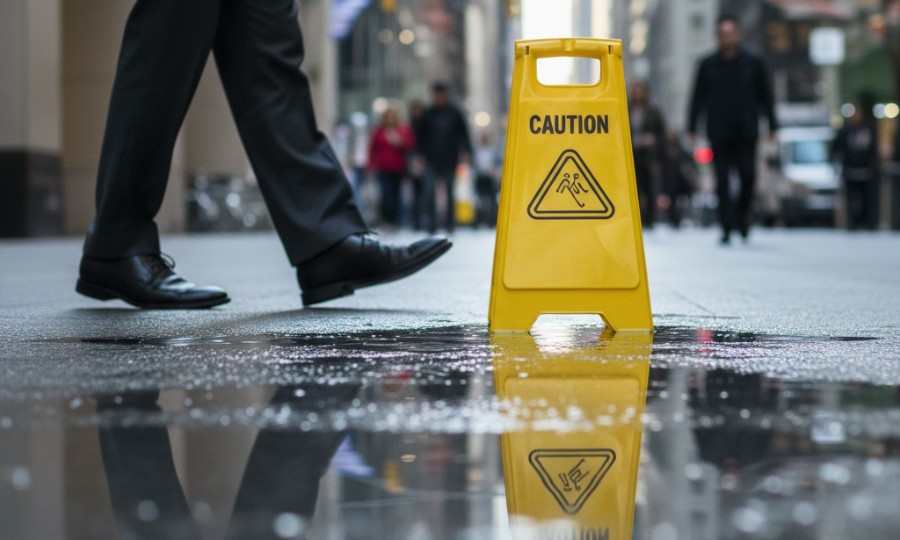
Ever walked down a bustling New York City street, minding your own business, only to suddenly find yourself flat on the pavement after a slip and fall? It’s a jarring, often painful experience, and unfortunately, it’s far too common in our vibrant, crowded city. One moment you’re fine, the next you’re grappling with pain, potential injuries, and a heap of questions. You might be wondering, “Was this my fault, or was someone else responsible?” The truth is, if someone else’s carelessness caused your fall, you might have a valid personal injury claim. But how do you really prove that someone else’s negligence led to your painful injury? That, my friends, is the cornerstone of any successful NYC slip and fall accident claim.
Here’s the thing: merely falling isn’t enough to secure compensation. You’ve got to establish negligence, which essentially means proving that a property owner or manager failed in their duty to keep their premises reasonably safe, and that failure directly led to your accident and injuries. It sounds complex, doesn’t it? Don’t worry, we’re going to break it all down for you. We’ll explore the critical elements of negligence, look at common challenges you might face, and outline how you can build a robust legal argument, all tailored to the specific landscape of New York City.
Understanding Negligence: The Heart of Your Claim
So, what exactly do we mean by “negligence” in a legal sense? In personal injury law, negligence is defined as a failure to exercise the care that a reasonably prudent person would exercise in similar circumstances. For a slip and fall case in New York, you generally need to demonstrate four key elements:
- Duty: The property owner owed you a duty of care.
- Breach: The owner breached that duty.
- Causation: The breach directly caused your injury.
- Damages: You suffered actual damages (injuries, financial losses) as a result.
It’s like connecting the dots, isn’t it? Each point has to be proven for your claim to hold up. This isn’t just about pointing fingers; it’s about demonstrating a clear legal responsibility that was shirked, leading to your harm.
Duty of Care in the Big Apple
In New York City, property owners, whether they manage a swanky Fifth Avenue boutique, a bustling subway station, or a quiet residential building in Brooklyn, have a legal responsibility to maintain their premises in a reasonably safe condition for visitors. This isn’t an absolute guarantee against all accidents (life happens, after all), but it does mean they must take reasonable steps to prevent foreseeable hazards. The specific duty owed can sometimes vary slightly based on your status as a visitor – are you an invitee (like a customer in a store), a licensee (like a social guest), or a trespasser? In most cases, if you’re lawfully on the property, the owner owes you a duty to keep the premises reasonably safe.
Breach of Duty: When Owners Fall Short
This is where we get into the “what went wrong” part. A property owner breaches their duty of care when they fail to take reasonable steps to address a dangerous condition. This could mean they:
- Created the hazardous condition themselves.
- Knew about the hazard but failed to fix it or warn visitors (e.g., a “wet floor” sign).
- Should have known about the hazard because a reasonable property owner inspecting their premises regularly would have discovered it.
Let’s consider an example: Imagine you’re doing your weekly grocery shopping at a busy Manhattan supermarket. An employee mops an aisle but doesn’t put up a “wet floor” sign. You turn the corner, slip on the damp tile, and fall, twisting your ankle. Here, the supermarket arguably breached its duty by failing to warn customers of a known hazard. They created the wet floor, didn’t provide a warning, and a reasonable person would expect a warning in such a situation. That’s a clear breach, wouldn’t you say?
Causation: Connecting the Dots to Your Injury
Once you’ve established that a duty was owed and breached, you then need to prove causation. This means showing a direct link between the property owner’s negligence and your injuries. Lawyers often talk about “but for” causation – “but for” the owner’s negligence, would you have been injured? If the answer is no, then causation is likely established. You also need to demonstrate “proximate cause,” meaning your injuries were a foreseeable result of the owner’s actions (or inactions). It can’t be some far-fetched, unrelated chain of events.
Think about it this way: Let’s say you trip over a broken, unrepaired stair in a dimly lit stairwell of an apartment building in Queens. The landlord knew about the broken step for weeks but chose to ignore it. You fall and break your wrist. “But for” the landlord’s failure to repair that step, you wouldn’t have fallen. Your broken wrist is a direct and foreseeable consequence of that unaddressed hazard. This isn’t a stretch; it’s a logical connection. This element is absolutely crucial because without it, even if a hazard existed, your claim might not stand up.
Damages: What You’re Owed
Finally, for a negligence claim to be valid, you must have suffered actual damages. These aren’t just theoretical harms; they’re quantifiable losses that stem from your injury. In a slip and fall case, damages typically include:
- Medical Expenses: Past and future costs for doctor visits, hospital stays, medication, physical therapy, and any necessary surgeries.
- Lost Wages: Income you’ve lost due to being unable to work, both in the past and any projected future earnings if your injury impacts your long-term earning capacity. (Given NYC’s cost of living, these can add up quickly!)
- Pain and Suffering: Compensation for the physical pain, emotional distress, discomfort, and reduced quality of life caused by your injuries.
It’s important to keep meticulous records of all your medical treatments, expenses, and any time you’ve missed from work. This documentation becomes vital evidence when calculating the full scope of your damages.
Common Challenges in NYC Slip and Fall Cases (and How to Face Them)
Even with a clear understanding of negligence, slip and fall cases in New York City aren’t always straightforward. Property owners and their insurance companies often employ various defenses to minimize their liability. You might be thinking this won’t work because they’ll just deny everything, right? Well, they often try! Here are a few common hurdles:
- Lack of Immediate Evidence: Hazards like spilled liquids can disappear quickly, or icy patches can melt. This makes immediate documentation critical.
- “Open and Obvious” Defense: The owner might argue the hazard was so obvious that you should have seen and avoided it. However, this defense isn’t always a slam dunk, especially if there were distracting circumstances or the hazard was unavoidable.
- Comparative Negligence: New York is a “pure comparative negligence” state (New York Civil Practice Law and Rules, Article 14-A). This means if you are found partially at fault for your fall, your compensation will be reduced by your percentage of fault. For example, if you’re awarded $100,000 but found 20% at fault, you’d receive $80,000. It’s a critical aspect of NY law to understand.
Consider this scenario: You’re walking on a sidewalk in front of a commercial building in December, and a patch of ice, not easily visible, causes you to slip. The property owner hadn’t cleared the ice, even though it had snowed the day before, which is often a violation of local ordinances. The owner might argue the ice was “open and obvious,” but if it was partially obscured or blended with the pavement, your argument for their negligence strengthens significantly. This is where the nuances of the law really come into play.
Building Your Strongest Case: Essential Steps
If you’ve suffered a slip and fall in NYC, taking immediate action can significantly bolster your claim. We know this feels overwhelming, especially when you’re in pain, but these steps are truly vital:
- Document the Scene: If possible, take photos and videos of the hazard, your injuries, and the surrounding area immediately after the fall. Note the date, time, and specific location.
- Seek Medical Attention: Even if you feel okay, get checked out by a doctor. Some injuries might not be immediately apparent, and medical records are crucial evidence.
- Identify Witnesses: If anyone saw your fall, get their contact information. Their testimony can be invaluable.
- Report the Incident: Notify the property owner or manager in writing as soon as possible.
- Consult Legal Counsel: This is arguably the most important step. An experienced NYC personal injury attorney can investigate your claim, gather evidence, negotiate with insurance companies, and represent your best interests in court. They understand the intricacies of New York State law and local ordinances, which is something you definitely want on your side.
Proving negligence in an NYC slip and fall accident isn’t a simple task; it requires a deep understanding of legal principles, a meticulous approach to gathering evidence, and often, the ability to counter aggressive defense tactics. It’s not something you should try to navigate alone. Your focus should be on your recovery, and let professionals handle the legal heavy lifting. We believe everyone deserves fair compensation when their injuries are caused by someone else’s carelessness, and that’s why understanding these core elements of negligence is so empowering. Don’t let the complexity deter you from seeking the justice you deserve.
Free Case Consultation
Injured in an accident? Contact Rosenberg, Minc, Falkoff & Wolff for a free and confidential case review with an experienced NYC personal injury attorney.


